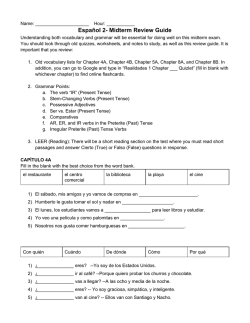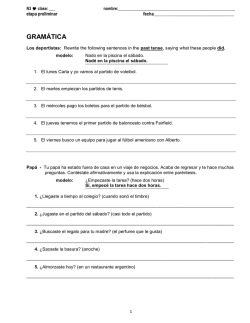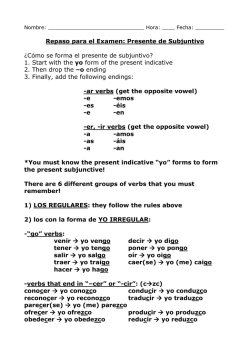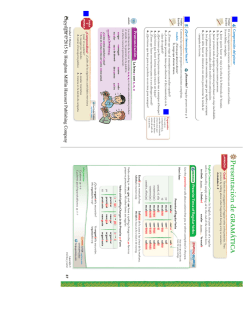
- ar preterit notes
Hola estudiantes, We hope that your experience during Spanish 1 was enjoyable and that you are looking forward to improving your ability to communicate in Spanish. As we all know, it is very difficult to go from a period of no exposure to a language to full exposure (think of going from your History class to your Spanish class... it isn't easy, is it?) In an effort to minimize the shock of going right back into Spanish, we would like you to do some of the following work to shake out some of those webs that develop in our brains from inactivity. The work should not take too long, and it is a review of the last material you covered, the past tense, or the preterit. Again, we hope that this jogs your memory a bit before you come back to school. THIS WORK MUST BE READY BEFORE THE FIRST CLASS MEETING!! Muchas gracias, Señor Pedro Cafasso Chair, Language Department ¡Disfruten su verano! PLEASE IMPORT INTO NOTABILITY - THEN "HANDWRITE" THE ANSWERS - TYPED WORK WILL NOT BE ACCEPTED!!! Nombre y apellido ________________________________________ Fecha _________________________________ El pretérito CONJUGATE In Spanish, we ___________________ (or change the endings) of verbs in order to say WHAT the action is done. WHO ____________ is doing the action and ___________ habla hablo hablamos s/he talks I talk we talk (present tense) (present tense) (present tense) TENSES There are many different _______________ in Spanish and in English. Some tenses are used to describe present action (as in the above examples), others describe past action, others describe future action, and still others describe possible or hypothetical action. PAST The preterit tense is one of the tenses that is used to describe _____________ action. SPECIFIC Specifically, it is used to talk about things that happened at a _________________ time in the past. All actions that are described using the preterit tense have a clear beginning and a clear end: they started and ended in the past. COMPLETED They are _________________ actions. Ex: I went to the store. We ate ice cream together. Did you find the book? He ran in the track meet. As with the present tense, there are different preterit tense endings for verbs that end in -AR (like ‘hablar’) and verbs that end in -ER or -IR (like ‘comer’ or IRREGULAR ‘vivir’). There are also ___________________ verbs that do not follow the same conjugation patterns as regular verbs do. Here are some words that will help you talk about the past in Spanish: ayer anoche entonces (la semana) pasada (el mes) pasado esta mañana hace (dos días) yesterday last night then last (week) last (month) this morning˜ (two days) agoé hace (un año) (a year) agoñ el otro día de repente the other day suddenly Copyright © 2013 Martina Bex ● www.martinabex.com ● The Comprehensible Classroom "HANDWRITE" THE ANSWERS - TYPED WORK WILL NOT BE ACCEPTED!!! Let’s look at the regular preterit tense endings for -AR verbs. Regular Preterit -AR Verb Endings yo nosotros tú vosotros él, ella, Usted ellos/as, Uds. Notice that the ‘nosotros’ ending is the same in both the present and preterit CONTEXTUAL tenses. This means that you need to use ____________________ clues to determine which tense is being used when you read or hear a verb that ends in -amos. Use the above chart to help you answer the remaining questions on this page. Write the meaning of these sentences in English: Hablé con mi amigo ___________________________________ Caminaste a casa. ___________________________________ Gritó a su hermano. ___________________________________ Lloraron en el cine. ___________________________________ WHO did the action Notice that the endings of the verbs tell you _________ PAST and that the action was done in the ___________. The stem (the first, WHAT underlined part) of the verb tells you ____________ that person did. Conjugate these verbs using the verb chart: she talked (hablar) ___________________________________ they jumped (saltar) ___________________________________ we thought (pensar) ___________________________________ I cried (llorar) ___________________________________ you sang (cantar) ___________________________________ Copyright © 2013 Martina Bex ● www.martinabex.com ● The Comprehensible Classroom "HANDWRITE" THE ANSWERS - TYPED WORK WILL NOT BE ACCEPTED!!! Now, read this story. It is written in the past tense: Ayer, yo caminé a la escuela con mi amiga Nedelín y sus AFICIONADOS DEL FÚTBOL hermanos. Nedelín y sus hermanos hablaron del fútbol, el deporte favorito de su familia. El fin de semana pasado, yo pasé tiempo con su familia, y nosotros miramos un partido de fútbol en la televisión. Nedelín y sus hermanos gritaron mucho, pero nadie gritó más que su padre. Él gritó cuando su equipo favorito (México) marcó un gol, y gritó más cuando marcó el otro equipo (Argentina). Al final del partido, el padre de Nedelín lloró porque el equipo de Argentina ganó el partido. marcar - to score partido - game aficionados - fans equipo - team First, underline all verbs that are conjugated in the preterit tense. Use the -AR preterit verb endings chart to help you identify them. Next, sort the underlined yo _______________ él, ella, Ud. _______________ nosotros _______________ ellos _______________ verbs by subject. You do not need to list duplicates: _______________ _______________ _______________ _______________ _______________ Finally, re-write the story in the present tense. Remember to eliminate or modify words that refer to the past, like “yesterday”or “last weekend”: ___________________________________________________________________________________ ___________________________________________________________________________________ ___________________________________________________________________________________ ___________________________________________________________________________________ _____________________________________________________ _____________________________________________________ _____________________________________________________ _____________________________________________________ _____________________________________________________ _____________________________________________________ Present Tense -AR Endings yo tú él, ella, Usted nosotros vosotros ellos/as, Uds. -o -as -a -amos -áis -an _____________________________________________________ Copyright © 2013 Martina Bex ● www.martinabex.com ● The Comprehensible Classroom Nombre "HANDWRITE" y apellido ________________________________________ FechaBE ______________________ THE ANSWERS - TYPED WORK WILL NOT ACCEPTED!!! El pretérito: Verbos que terminan en -ER o -IR We recently learned about the preterit tense. The preterit tense is used to talk about things COMPLETED that happened at a specific time in the past: it is used to talk about ______________________ actions. HABLAR So far, you have only learned the endings for verbs that end in -AR, like _________________, CAMINAR MIRAR __________________, and __________________. Let’s review the preterit endings for -AR verbs: ‘yo’ ending: _______ I talked: _______________________ ‘tú’ ending: _______ you talked: _______________________ ‘él, ella, Ud.’ ending: _______ s/he talked: _______________________ ‘nosotros’ ending: _______ we talked: _______________________ ‘vosotros’ ending: _______ y’all talked: _______________________ ‘ellos/as, Uds.’ ending: _______ they talked: _______________________ The endings for regular -ER and -IR verbs are very similar to the -AR endings: yo nosotros tú vosotros él, ella, Usted ellos/as, Uds. Notice that -ER and -IR verbs have the SAME endings in the preterit tense (in the present tense, each kind has its own set of endings). Write the meaning of these sentences in English: Comí mucha pizza. ___________________________________ Escribiste un ensayo. ___________________________________ Vivió con su madre. ___________________________________ Salieron con amigos. ___________________________________ Copyright © 2014 Martina Bex ● www.martinabex.com ● The Comprehensible Classroom ● 3 Nombre "HANDWRITE" y apellido ________________________________________ FechaBE ______________________ THE ANSWERS - TYPED WORK WILL NOT ACCEPTED!!! Use the chart on the previous page to help you answer these questions: she drank (beber) Conjugate these verbs using the verb chart: ___________________________________ they learned (aprender) ___________________________________ we slept (dormir) ___________________________________ I ran (correr) ___________________________________ you attended (asistir) ___________________________________ Now, read this story. It is written in the past tense: El fin de semana pasado, mis padres y yo asistimos al funeral de mi abuelo. En el programa, yo leí una biografía breve de mi abuelo. Mi tía (la hermana de mi padre) escribió la biografía, y ¡yo aprendí mucho que no sabía antes! Él nació en Colombia, y conoció a mi abuela cuando tenía quince años. Ellos decidieron salir de Colombia porque había mucha violencia allí. Salieron de Colombia en 1960 e inmigraron a los Estados Unidos. Aprendieron inglés de un amigo, y vivieron en Kansas por 50 años. Mi abuelo trabajó en un rancho y también en una fábrica. Sus hijos (mi padre y sus hermanos) nacieron aquí y aprendieron inglés en la escuela. Me divertí mucho hablando con mis familiares y recordando la vida de mi abuelo. First, underline all -ER and -IR verbs in the story that are conjugated in the preterit tense. Use the verb endings chart on the previous page to help you identify them. Next, sort the underlined verbs by subject. You do not need to list duplicates: yo él, ella, Ud. nosotros ellos _____________ _____________ _____________ _____________ _____________ _____________ _____________ _____________ _____________ _____________ _____________ _____________ Finally, re-write the story from the GRANDFATHER’S perspective (as if he were an angel observing his own funeral and describing his life). Write the story in Spanish on a separate piece of paper. Copyright © 2014 Martina Bex ● www.martinabex.com ● The Comprehensible Classroom ● 4 PLEASE READ THE FOLLOWING ARTICLE. ANY WORDS YOU DO NOT UNDERSTAND, PLEASE LOOK UP BY USING "WORDREFERENCE.COM" ONLY - DO NOT INSERT INTO "GOOGLE THEN ANSWER THE QUESTIONS BELOW Fecha ON ADDITIONAL SHEET. NombreTRANSLATE". y apellido __________________________________________ _________________ El hotel basura Enero de 2011 - En Madrid, la capital de España, hay un hotel muy popular en una plaza pública. Es un hotel nuevo, pero es muy sucio. Es sucio porque está construído totalmente de basura. El hotel se llama Hotel “Save the Beach” (Salvar la Playa) y fue construído para llamar la atención al problema de la basura en los oceános y las playas de Europa. El artista que diseñó el hotel se llama H.A. Schult. Él quiere que los líderes póliticos busquen soluciones para el problema de la basura. La basura es mala para los animales que viven en las playas y en el océano y también para los humanos. Hay basura--papeles, ropa, botellas de plástico y más-en todas las paredes del interior y del exterior del hotel. En el hotel, hay cinco habitaciones. No es un hotel grande porque es transitorio: el artista mueve el hotel a ciudades diferentes para llamar atención al problema. Antes de estar en Madrid, el hotel estaba en Canadá, Vietnam, Pakistán, Italia y otros países. En Madrid, el hotel está abierto por cinco días y todas las habitaciones están ocupadas durante ese tiempo. Durante el día, el público puede visitar el hotel. Para más información sobre el proyecto, visita www.coronasavethebeach.org. 1. What is the purpose of the hotel? 1. ¿Hay un problema de basura en tu ciudad? Explica tu respuesta. 2. According to the article, what are two groups affected by the trash problem? 2. ¿Tú quieres pasar una noche en el Hotel Save the Beach? ¿Por qué sí o no? 3. What are some things you find in the hotel? 3. ¿Te interesa construir una versión del Hotel Save the Beach en tu ciudad? Explica tu respuesta. 4. For how long was the hotel open in Madrid? 4. ¿El Hotel Save the Beach es una buena manera de llamar atención al problema de la basura? Explica tu respuesta. Copyright © 2012 Martina Bex ● www.martinabex.com "HANDWRITE" THE ANSWERS - TYPED WORK WILL NOT BE ACCEPTED!!! ___________________________________________________________________________________ ___________________________________________________________________________________ ___________________________________________________________________________________ ___________________________________________________________________________________ ___________________________________________________________________________________ ___________________________________________________________________________________ ___________________________________________________________________________________ ___________________________________________________________________________________ ___________________________________________________________________________________ ___________________________________________________________________________________ ___________________________________________________________________________________ ___________________________________________________________________________________ ___________________________________________________________________________________ ___________________________________________________________________________________ ___________________________________________________________________________________ ___________________________________________________________________________________ ___________________________________________________________________________________ ___________________________________________________________________________________ ___________________________________________________________________________________ ___________________________________________________________________________________ ___________________________________________________________________________________ ___________________________________________________________________________________ ___________________________________________________________________________________ ___________________________________________________________________________________ ___________________________________________________________________________________ ___________________________________________________________________________________ ___________________________________________________________________________________ ___________________________________________________________________________________ ___________________________________________________________________________________ ___________________________________________________________________________________ ___________________________________________________________________________________ ___________________________________________________________________________________ ___________________________________________________________________________________ ___________________________________________________________________________________ ___________________________________________________________________________________ ___________________________________________________________________________________ ___________________________________________________________________________________ ___________________________________________________________________________________ ___________________________________________________________________________________
© Copyright 2024




